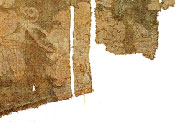 |
 |
|||||||||||||||||
 |
||||||||||||||||||
 |
||||||||||||||||||
| Classified Glossary | ||||||||||||||||||
 |
||||||||||||||||||
 |
||||||||||||||||||
| 52. 1Painting Using a brush with pigment to apply ornamental pattern on a textile, painting (huahui) is the prototype of printing and dyeing (yinran). Many examples were found in Han to Liao textiles, 2nd century BC to 10th century AD. 53. 1Printing Printing with carved blocks, included two methods, stamp printing (tubanyinhua) with convex blocks, such as the textiles from Mawangdui; and stencil printing (loubanyinhua) with a concave plate, which was very popular in the Song dynasty. 54. 1Tie dyeing Tie dyeing (jiaoxie or zaran) is a method of resist dyeing - before dyeing a series of knots is made in the textile, so when it is dyed the dye does not penetrate the knotted area. This method appeared in the 3rd to 4th century and is used still today. 55. 1Clamp-resist dyeing Clamp-resist dyeing (jiaxie, commonly known in English by the Japanese term kyokechi) uses two symmetrically carved concave blocks to clamp the folded textiles and dye, then the pattern of the convex part is obtained. It is said that the sister of Liu Jieshu in the reign of Emperor Xuanzong in the Tang dynasty, 712-756AD, invented the method, which was very popular in the Tang and Song dynasties and was used for tanka covers in the Ming and Qing dynasties. |
||||||||||||||||||
| THE BOOK | ||||||||||||||||||
| AUTHOR | ||||||||||||||||||
| CONTENTS | ||||||||||||||||||
| ORDER | ||||||||||||||||||
| CONTACT | ||||||||||||||||||
| LINKS | ||||||||||||||||||